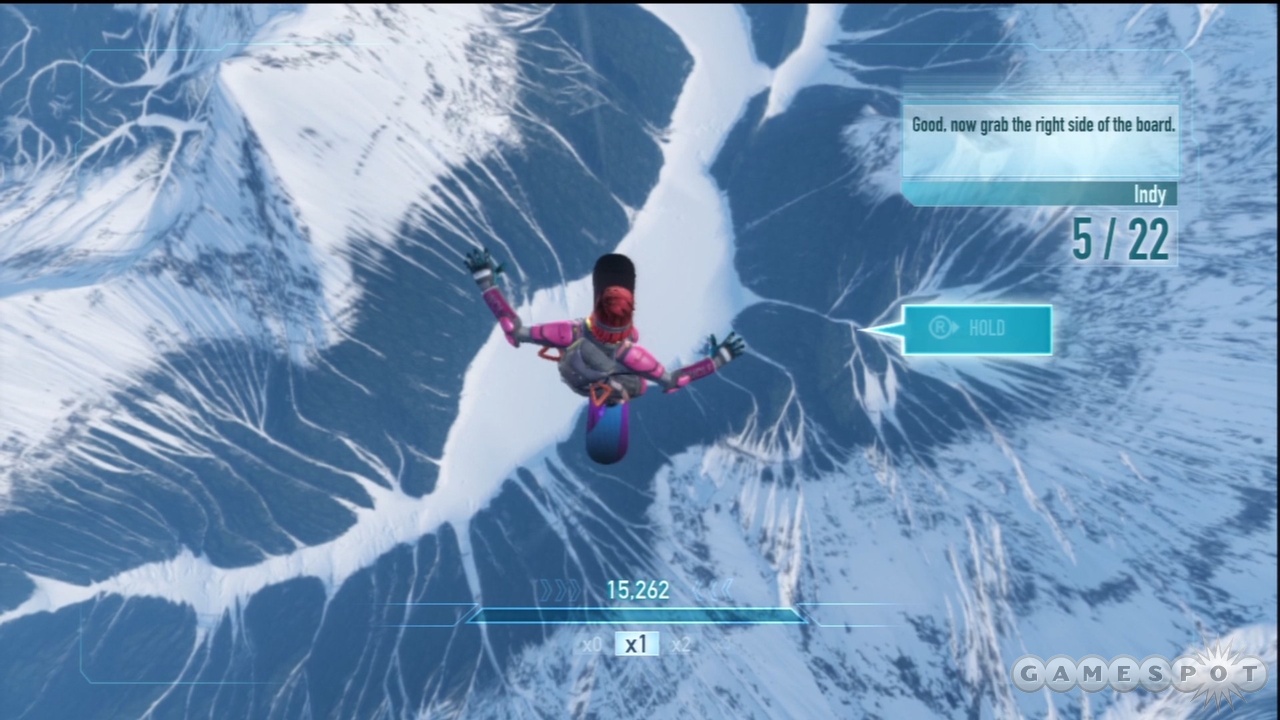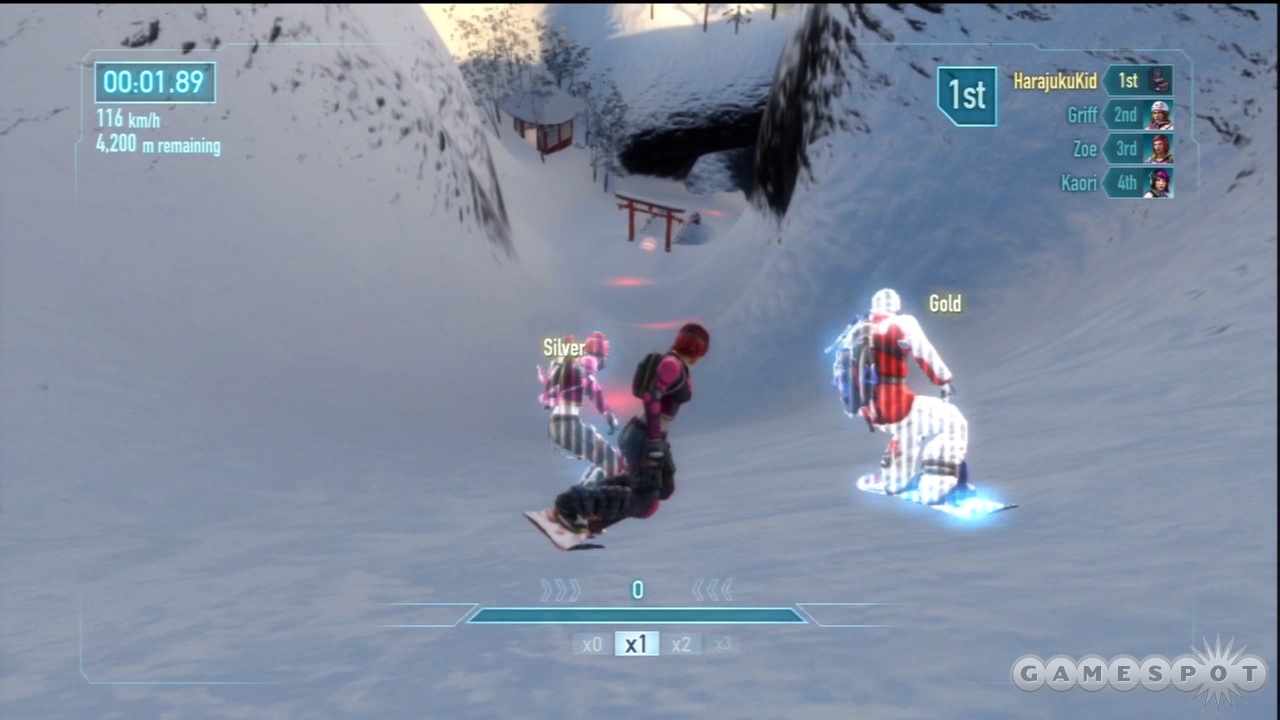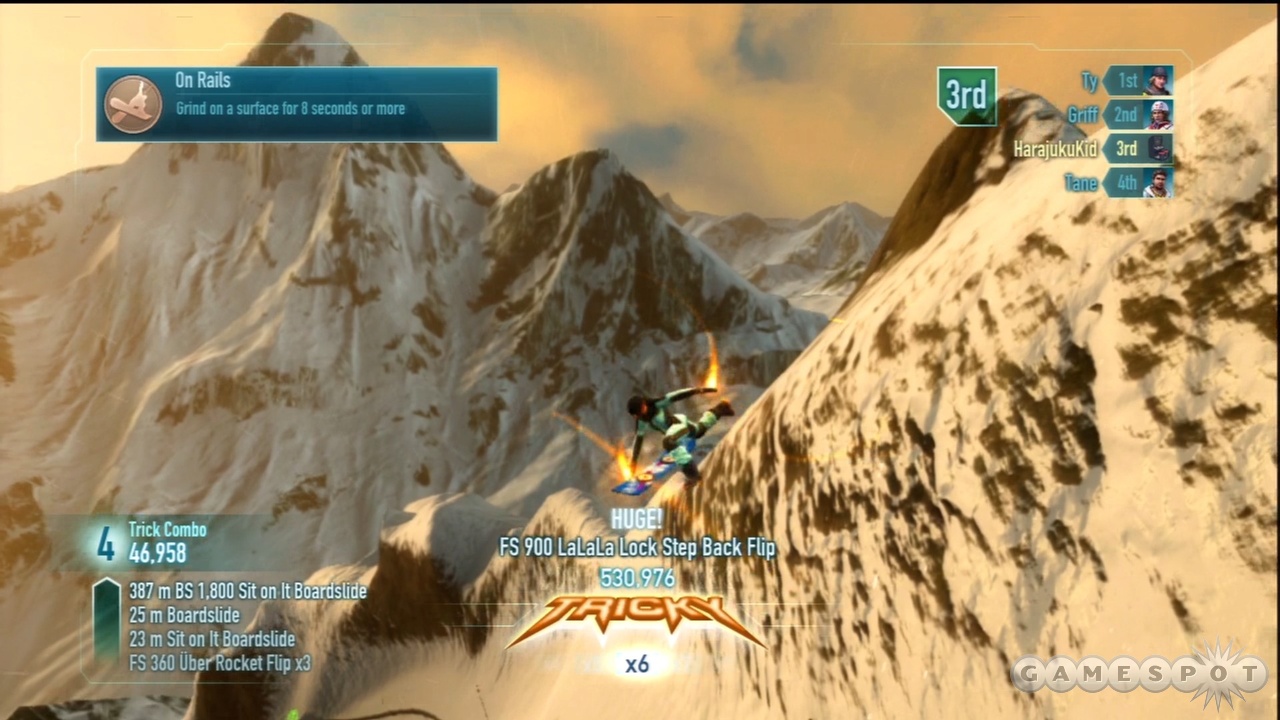"Go big or go home!" Elise Riggs of SSX shouts this from the skies as she catches big air off of some of the tallest mountains in the world. It's a fitting credo, both for Elise and for SSX itself, and presented with those two alternatives, the SSX series has most definitely gone big. From its inception, it has been about snowboard racing and tricking on a superhuman level. Appropriately, the 2000 original was the first game released under the EA Sports BIG brand, and its two direct sequels were each bigger and better games than the last. But this SSX sets a new standard for the series, with a varied and dangerous world, a more incredible sense of speed, and competition on a massive scale. This is the SSX game fans of the series have been longing for, and the heart-pounding thrills to be had in conquering these mountains are sure to turn many newcomers into fans as well.
Whether you're playing the single-player World Tour mode or competing against other players, most of your time in SSX is spent racing or tricking your way down snowy mountain courses. Those courses are set in Alaska, Siberia, the Alps, and 7 other regions, and although they're much more rooted in reality than those seen in many SSX games, these real-world locations have been given the extreme treatment. You won't leap over congested freeways or speed down the slope of an oversized pinball machine as in previous games, but you will trick off of your helicopter and grind on rails that snake through the cavernous heart of Kilimanjaro. The PS3 version includes the exclusive Mount Fuji of Japan, which you get when you redeem the online pass that's enclosed with new copies of the game and can be purchased separately from the online store. Mount Fuji is one of the more tranquil environments in the game, and the only one that doesn't have a deadly descent associated with it.
The environments are vast and majestic. Details like sunlight sparkling on the surface or swirling flurries of snow capture the natural beauty, as well as the harsh conditions, of these locales so effectively that you can almost feel the bracing air enter your lungs. These details become all the more impressive when you fly past them; the smooth frame rate and immersive environments come together to create a truly impressive and exhilarating sense of speed. During a good run, the way you flow seamlessly from one thing to the next--from boosting down a slope to grinding along a rail to tricking wildly through the air--can make you feel like a superstar.
Tricks are central to SSX even during race events because pulling tricks off is how you fill your boost meter. The controls for tricking are intuitive and feel great, and they allow you to use either the right thumbstick or the face buttons. If you want to grab the left side of your board with your left hand, you simply press the thumbstick left or hit square. If you want to grab the front of your board with your right hand, you quickly tap right or circle to indicate your right hand and then up or triangle to indicate the front of the board. All the while, you can use the left thumbstick to spin and flip effortlessly. The simplicity of the controls makes doing what you want to do a snap. If you prefer something that more closely resembles the controls of the early SSX games, there's a "classic" control option as well.

It's the risk-versus-reward element of tricking that makes it so exciting. When you catch big air, you want to trick as long as you can to maximize your boost (and your points, if it's a trick event), but if you hold it for just an instant too long, you wipe out when you hit the ground, and all your tricking was for naught. Do you do simple ground tricks to maintain your combo and keep building up your score multiplier? Or do you play it safe and stop tricking to cash in the combo with your current multiplier? It's a balance you constantly need to maintain to get the best times and highest scores, and it's so rewarding to stick the landing after pulling off an especially risky trick combination.
The thrill of such moments is enhanced by the great sound design. The eclectic soundtrack includes shimmering pop, funky R&B, and pulsating electronica, and when you leap from a mountain to catch big air, the music fades, as if it emanates from the surface down below. When you hit the ground, it kicks back in at full strength. If you've tricked enough to fill up your boost meter, the music gets remixed into Run-DMC's "It's Tricky," which reprises its significant role from SSX Tricky in this game. Being in the "tricky" state also means you have unlimited boost while it lasts, and you can do ubertricks, which are worth more points. Score enough points in this mode and you get access to even wilder super ubertricks. The relationship between the game's adapting music and your actions gives your landings a satisfying sonic impact that complements the physical one.
Satellite surveys of the real-world mountain regions in SSX were used in forming the terrain, but clearly the hands of humankind have molded these environments to make them not only traversable but also conducive to high speeds and big trick opportunities. The end results are exceptional; numerous viable routes and intertwining pathways make the environments feel organic, which makes you feel like you're pioneering your own way down these slopes. Your helicopter pilot surveys the terrain from overhead and sometimes provides warnings about upcoming hazards or suggestions about which route to take, not entirely unlike a co-driver in a rally racing game informing you of upcoming turns. These tips can be quite helpful--particularly until you've done a run enough times to learn its ins and outs for yourself--but if you find the pilot's chatter distracting, you can always turn it off.
Earlier SSX games never needed anything like this guidance because there was rarely much danger. There was little sense that you were competing against the environment itself, but the new SSX is different. It's much more challenging; the environments are more treacherous; and in the single-player World Tour mode, your AI opponents are tough enough to put your skills to the test. There may be many viable routes through these courses, but there are also numerous pitfalls, and if you fall into a chasm (you will), the game won't just reset you back on the course. Instead, you must use the rewind feature (similar to the one seen in many auto racing games of late) to roll time backward and find a suitable spot to resume your run from, but this is not without its penalty. In race events, other riders continue on unaffected, and there's a particular sting to seeing an opponent fly forward past you while you are moving yourself backward out of disaster. In trick events, where the winner is the one who scores the most points, rewinding carries with it a point penalty.
And then, there are the deadly descents, the most grueling events in SSX. There's one in each region; each presents a different sort of challenge and limits your number of rewinds. If you first approach these via the World Tour, there's a smooth difficulty curve that makes advancing from one to the next easier. Your first is Mount Robson in the Rockies, a course littered with trees. High speeds and huge tricks are unimportant here; it's all about maneuvering carefully to avoid impact with these natural hazards. Failure here and on subsequent deadly descents is likely, and you may get frustrated, but when you finally master the terrain, there's a real feeling of triumph. Weaving and leaping your way through a tangle of trees unscathed is all the more exhilarating because there's a very real possibility of an ugly wipeout.
A few deadly descents require you to make active use of new equipment; the coolest example is Patagonia's Fitz Roy, where you need to employ a wingsuit to glide through the windy air and over some chasms. Some of the deadly descents work better than others; the freezing cold of the shadows on Antarctica's Mount Slaughter is a thrilling threat to avoid, while the constant encroachment of tunnel vision brought on by oxygen deprivation on Mt. Everest is more of an annoyance. But on the whole, these challenging runs are a great way to close out your time in each region in the World Tour, and they're a great place for multiplayer competition as well.
The World Tour is a good way to familiarize yourself with the environments and mechanics of SSX, but the action really heats up in the robust multiplayer modes. The Explore mode lets you aim for medal targets and compete against times and scores set by friends on any of the dozens of runs around the game's globe. The performances of your friends here show up as ghosts, and the ghosts leave glowing trails in their wakes, which look cool and are quite useful. If a rival of yours charts a particularly speedy and efficient path through a run, for instance, you can see the route he or she took. Deadly descent events here challenge you and your friends to see who can travel the farthest; when you make it to the bottom of a run, you're sent right back up to the top via helicopter to continue racking up distance.
The other multiplayer option is Global Events, which are competitions that have set time limits; they might last for a day or a week, and tens of thousands of players can compete in them. Depending on how your performance stacks up against other entrants, you're placed in a bracket--diamond, platinum, gold, and so on--and the higher your bracket, the more credits you earn when the event comes to a close. SSX constantly keeps you updated on pertinent happenings in both the Explore and Global Events modes, informing you when a friend shatters your time in a certain race or when your performance no longer qualifies for a certain bracket. And it makes it easy to jump right back to one of those events to try to improve your performance.

Additionally, whether you're in Explore or Global Events, you can plant geotags in any spot you can reach, and they can be collected by other players. You want to make these as difficult to nab as possible, because the longer a geotag you plant goes uncollected, the more credits you earn. You might be inspired to approach a run completely differently than you otherwise would in the hopes of planting a geotag in a hard-to-reach spot or of grabbing one you can see but can't immediately figure out how to collect. With so many runs to conquer and so many ways to compete, it can be hard to walk away from SSX.
Still, the absence of a traditional simultaneous multiplayer mode is conspicuous. You can create a global event that's limited to just friends or friends of friends, but there's no option to create an event that places you and your friends at the starting line simultaneously. You might see your friends on the slopes in a global event, but without a coordinated start, it doesn't matter who actually crosses the finish line first; it matters who takes the least time to get there. You can always create a party and chat with friends as you hang out on the slopes, but it's still disappointing that the game doesn't have a built-in option for simultaneous social competition.
What do you do with the credits you earn for performing well across the game's various modes? Well, lots of things in the game cost credits. New gear for your characters--better boards or outfits that provide perks like a bonus to your trick multiplier--costs credits. Accessing many runs in Explore mode costs credits. Entering many global events costs credits. And it's conceivable that you might end up in a situation where you have to choose between doing some events you don't want to do to earn credits, or just shelling out actual money to acquire them. Yes, you can purchase them with cash. You're never forced to spend money, but the game may tempt you at times with a sweet new snowboard or other alluring item, and the monetization of credits makes the whole thing feel a bit tawdry.
But when you're actually on the slopes, the action is so good that you can lose yourself in the moment, joyously tricking and speeding your way down some of the most majestic mountains in the world. Whether you just want to relax and carve some sweet powder in the Rockies or you prefer a grueling struggle against the terrain and the elements, SSX has you covered. It improves on its storied predecessors in every way, with outstanding tracks, intuitive controls, amazing visuals, a diverse assortment of challenges, and fantastic multiplayer options that may have you competing with your friends or the world for a long time to come.
Editor's note: This review originally misstated the total number of regions included in the game. The review has been amended accordingly. GameSpot regrets the error.

